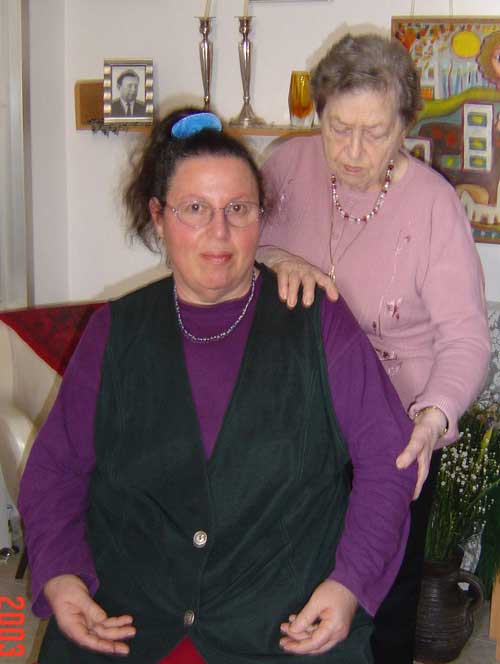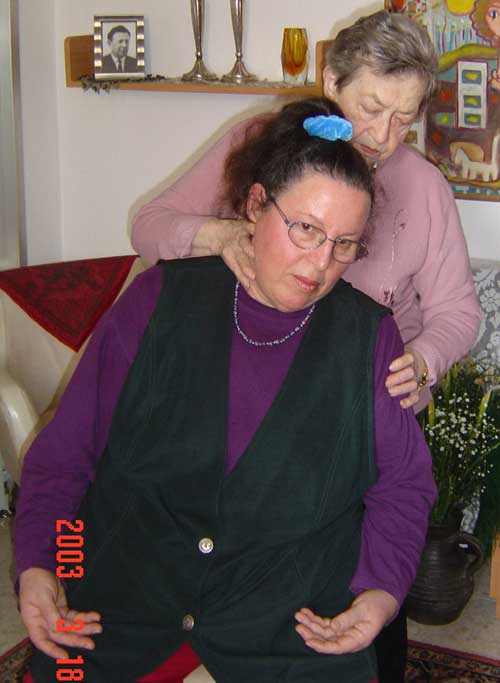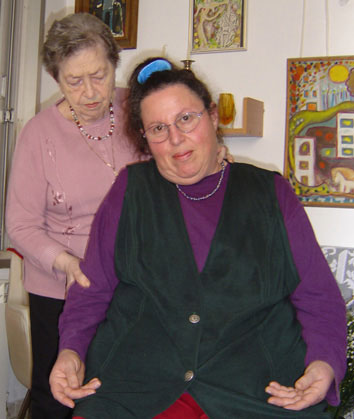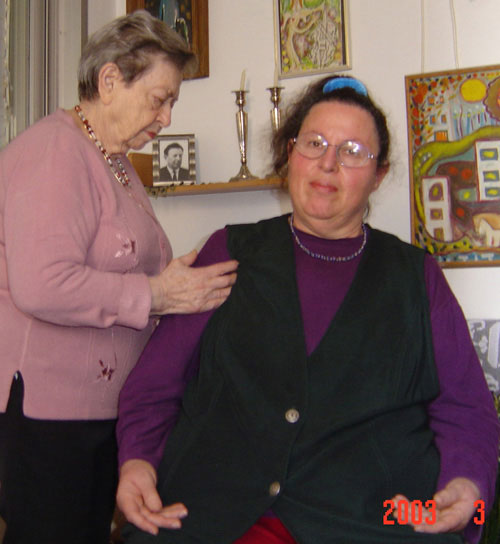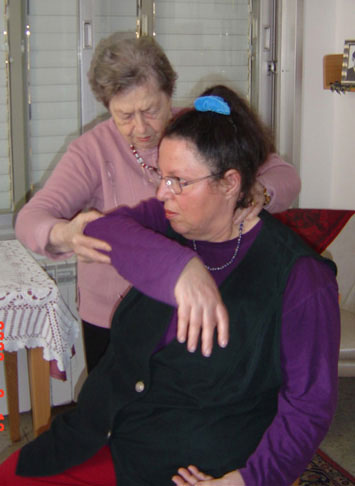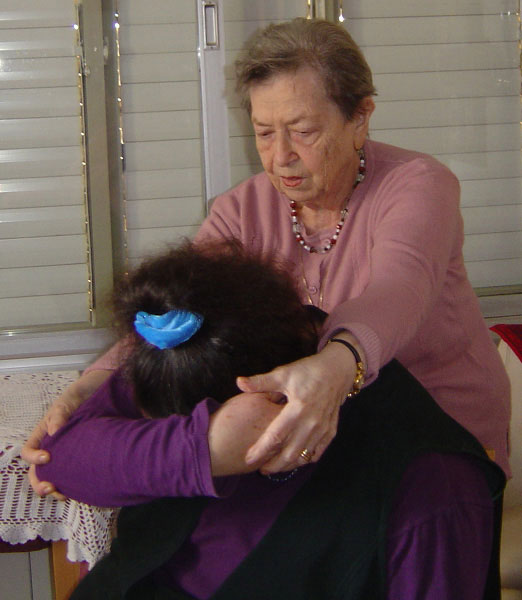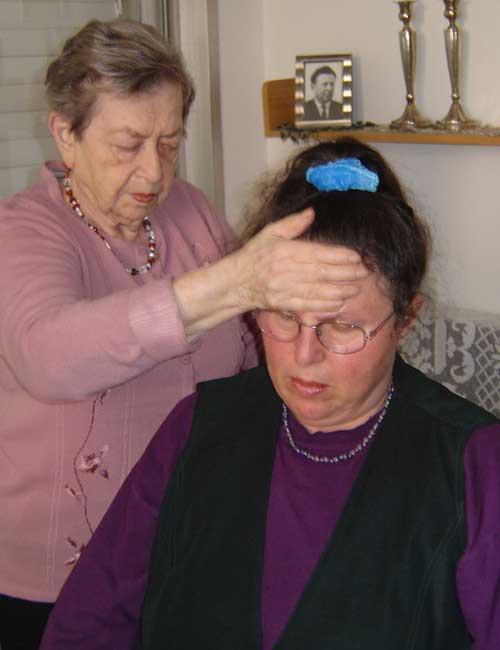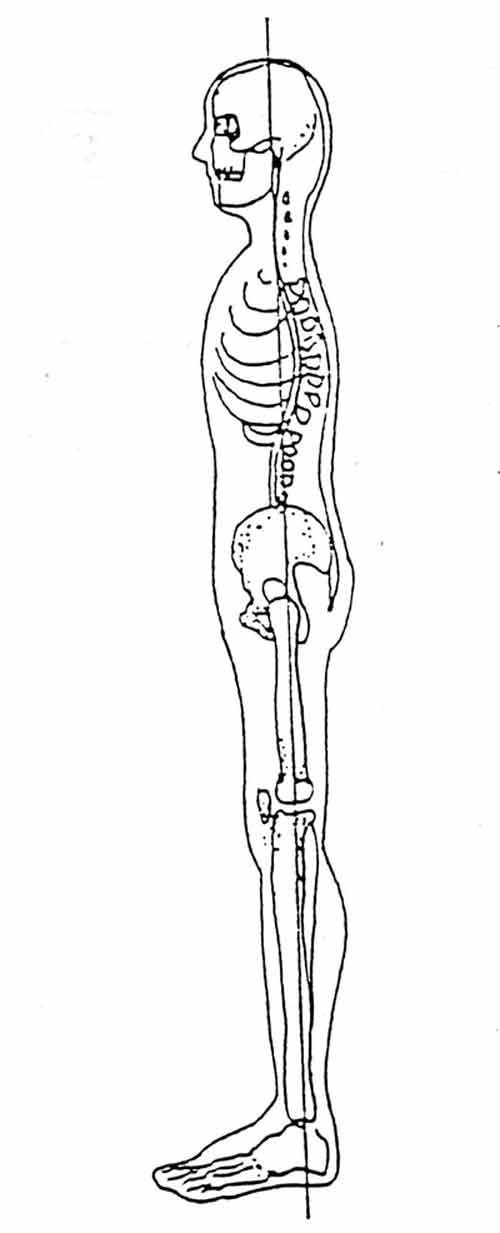|
Dynamic posture
Organizing the body
to a dynamic posture
by: Rinat Levin-Chervin
What is the importance of understanding the term: “correct
posture”, and why does this topic occupy us so much, in the
western world of the 20th century?
How do we benefit from a correct posture?
And what is the meaning of dynamic posture?
The most unchanging fact in life is
that everything changes.
The posture is individual, and varies from one person to another.
It relates to your personality and to what you do.
It is connected with your life circumstances, emotions, mood and
physique.
It is unique, and is the base to all you are.
An exercise in
understanding the term : “dynamic posture” – a task for two
The exercise is for 2 people, so you need to get a partner.
Prepare some paper and a pen to write down your findings.
a.
Rating the posture
Guide your partner to stand in a way that is most convenient and
easy for him/her, without changing anything. Now, look at picture
no.1, which describes a “correct posture”, set according to the
laws of mechanics, anatomy and physiology of the back. Compare the
way your partner stands, to the ideal posture. Rate your partner’s
posture on a scale from 1 to 10, where 10 denotes an excellent
posture. Give a name to your partner’s posture. Use various terms
such as: upright, bent, curved, designed like a question mark,
straight as a ruler, flexible, bouncy, stable etc.
b.
Can the posture be corrected?
If you could correct or improve your partner’s posture, what would
you do?
Design your partner, using your hands and verbal instructions. Do
it gently, while listening to his/her responses. Move various
parts of his/her body, so that he will “match” the description of
the “ideal posture” (picture 1).
If one of you get tired during the process, take a brief rest,
then carry on. Pay attention to his/her overall body length, the
location of his/her head and shoulders in relation to the spinal
cord, his/her concavity of the neck, the location of his/her
shoulders in relation to the head and the thorax. Notice the way
his/her hands are hanging, and their distance from his/her body.
Note their length – is it equal? What about the shoulders height –
is it equal? Are his/her shoulders leaning forward, or held
backwards? Note whether there are arched or concave areas in
his/her back, if so in which area, and whether they are
proportionately divided, or do some areas stick out more
conspicuously than other?
Note where his/her pelvic is
located in general, in relation to his/her shoulders, head and
legs. How does his/her pelvic support the spinal cord and the
head? Check the position of the legs, and how wide they are
spaced. Check the way his/her body weight load is distributed
between both legs. Does the person lean on one leg more than the
other? Does he lean on the outer, or inner part of the foot? Does
he tend to step more strongly on
his/her heel, or on his/her toes? Note the position of his/her
stomach, his/her bottom, etc. After you have finished “designing”
your partner, and you are pleased with his/her “perfect” posture,
look at your watch and measure how long he can remain in that
posture. Check whether he keeps breathing continuously. Does
he look comfortable? Are his/her eyes calm, or fixed? Note the
amount of effort he needs to make in order to stand without
change.
c. How will this
posture benefit a person who is in motion?
Ask your partner to remain “designed” in the “ideal posture”, and
at the same time to start walking, running, jumping, turning,
look right and left. Note whether his/her movement is gentle and
flowing, or discontinuous or inhibited? Do the movements look
comfortable and suitable to that person’s character, or do they
look forced and strained? Is his/her breathing continuous, or did
it stop when he moved? Does it seem to you that this “ideal”
person is ready for his/her daily activities? How much energy do
you think he will have to put into to start a movement? Instruct
your partner to return to his/her regular, comfortable posture and
note whether the changes you made in him during the exercise were
preserved, or whether that person returned to his/her original way
of standing.
Surely you have noticed that your partner has a typical posture,
which is not easy to change. In fact, if you look around, you will
notice that each person has his/her own typical way of movement.
Every person has a way of sitting, writing, shaking hands,
hugging, standing, walking and running. These are habits acquired
through the years, in accordance with one’s physique, hereditary
factors, surrounding, life experience, status and body image.
Note how different your posture is when you are present at an
interesting, useful lecture on an exciting subject, compared to
your posture when watching a boring program on TV. Note the change
in your posture when you do your job out of obligation, compared
to when you consider your work a challenge, an interesting life
opportunity, and perform it with enthusiasm. Your posture also
depends on your physique, and relates to it. The posture of a
person suffering from scoliosis is different from that of a person
suffering from lower back pain, projecting at times to the legs,
following a disc hernia. Are these people capable of a good
posture?
Usually, a person who remains in one, certain static posture for a
long time, gets tired. His/her breathing becomes disordered, and
there are signs of inconvenience, overload and strain in different
parts of the body. Check your findings regarding your partner. If
you look around, at your partner or even at yourself, you will see
that about 9 out of 10 people do not fill the requirements of an
excellent posture, rated 10. Most of you have certainly used the
terms “upright” or “straight posture” to verbally define your
partner’s posture. It is unsurprising, because the idea of
standing straight as a model for a correct posture, had always
been an axiom as far as posture is concerned.
However, in fact, the upright, straight standing is another
socially created, unchallenged, indisputably accepted idea. This
idea appears wherever we refer to correct posture, and it also
lies at the base of our feeling towards ourselves and our
behavior.
The posture
from an anatomic viewpoint
When you look at the structure of the spinal cord, you will
realize that it is made of vertebrae lying one on top of each
other, and is not a straight line. There are a few curves: in the
neck area, there is a forward leaning curve (lordosis). In the
chest area, a backward leaning curve (kifosis). In the waist area,
a forward leaning curve (lordosis), and in the sacrum area an
additional, smaller backward leaning curve (kifosis). These curves
enable the extreme mobility and flexibility.
These
concavities and arches mean a healthy, vital spinal cord.
A person who lacks these curves, or has them misplaced from their
proper location (like in scoliosis), has an "unhealthy" spinal
cord. He/she might find in the Feldenkrais method new
possibilities for his/her life.
The spinal cord is made of 29 vertebrae: 7 neck vertebrae, 12
thorax vertebrae, 5 waist vertebrae and 5 sacrum vertebrae. The
spinal cord is designed like an inverted “S”. This shape enables
it to fill its role, providing support to the head and back. It is
a stable, yet not rigid, support. Intervertebral discs (the
cartilage plates) connect the vertebrae. They are very flexible
and prevent concussion. The discs and the long straps provide
great elasticity to the spinal cord, enabling it to return to its
original shape, following diversions caused by load or strain at
some part or another along the cord.
An anatomic viewpoint disproves, therefore, the idea that there
could ever be a “straight” posture. If you really try to be
straight, you may suffer pain and damage.
The posture from a
functional viewpoint
I can say for certain, that when you asked your partner to start
moving, from that forced state of “ideal posture”, his/her
movements were awkward, not spontaneous, stiff, as well as
accompanied by inconvenience and effort.
When we move, a few
things happen:
a.
Shifting of weight
b.
Change in the action of the muscles upon the skeleton
c.
Change in the body organization as one whole unit
If you want to walk, run, jump, hang something, catch an object,
roll, kick, bounce a ball, turn, dance, lift a load, play an
instrument, sing, hug – you cannot remain in a static position,
and you cannot be straight. When functioning, you cannot remain
immobile or straight. The term “stability” is misleading, being
perceived, till today, as a static, immobile position.
However, posture
is about change and movement.
According to the Feldenkrais concept, posture is dynamic.
It is a concept unique to this method. The posture is conceived as
a mobile state, and refers to changes in position, requiring, in
turn, an internal organization of your body.
The posture is the internal dynamics of movement from place to
place. It is the way our system organizes itself in order to shift
anytime from one body position to another.
An example will be, shifting from sitting down to standing up or
from running to jumping to take a shot at the basket. The posture
is regarded as a process, a course of action in which an action
begins and ends in the most efficient way, without internal
resistance, or stopped breathing. Movement will be carried out by
putting in the minimal amount of energy required to complete the
action and achieve its target.
Posture is the ability to pass freely and uninterruptedly from one
body state to another.
Posture means being
ready for action.
Change has to
come from inside
From my working experience with a wide variety of people, I can
testify that when we try to “redesign” a person, force him
verbally, or directly correct his/her posture with our hands, into
a different, “ideal posture”, it simply does not work. The result
of such a corrected posture is a forced, strained and inconvenient
way of sitting or standing. Usually, the person will not be able
to remain in that posture for long. His/her eyes will become fixed
and he will halt his/her breath. After a few moments in this
forced position, the person would return to his/her regular
position. In short – an external guidance, whether verbal or
through correction does not contribute to posture improvement.
In order to improve a person’s posture, he should undergo a
gradual and continuous internal process in which learning would
occur. He must absorb and assimilate the changes, and what he had
learned, in his/her nervous system. This way he/she can adopt
various, different, easy and pleasant postures, without resisting
to them or activating any defense mechanisms.
A group or an individual lesson in the Feldenkrais method enables
you to undergo such an internal process, through listening to
yourself, and developing a kind of an “internal mirror”. At the
end of the lesson, your resulting posture grows closer to the
“ideal posture”. This reorganization is achieved without any
guidance or laws regarding “how should we sit and stand”, “which
posture is correct and which is not”, or “what is a straight or
non straight back”. The achieved posture is light and comfortable,
required no effort, energy or stop in breathing. From such
reorganization of your body, you can initiate movement in any
desired direction, without any special muscular-skeletal
preliminary adjustment. The learning process during the lesson is
such that during its course the student is the one to create the
changes and improvements, by himself. He moves, feels his/her
movements and learns.
From the Zen faith:
“Borrowed feathers do
not grow”
“Wisdom that does not
emerge from within you, has no value for you”
Published in:
“Briut al burya”, an Israeli alternative medicine magazine
|

